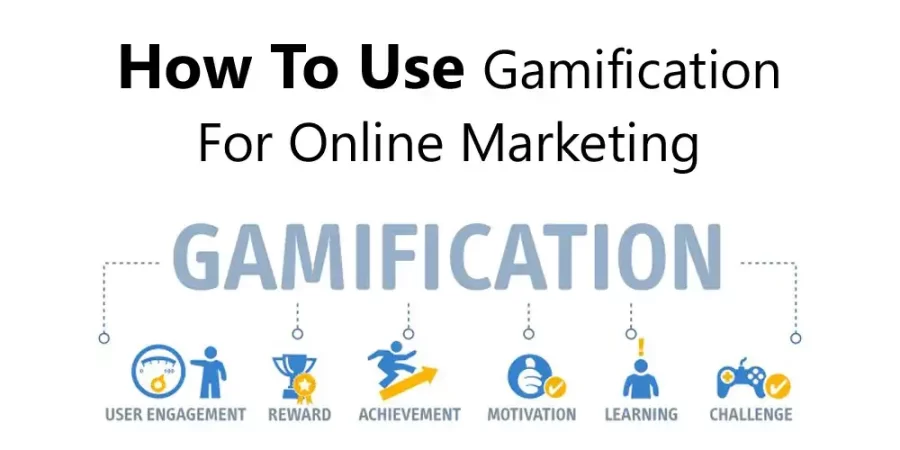Beginners Guide: How To Use Gamification For Online Marketing?
Gamification is the process of using game design elements and game mechanics to engage and motivate people to achieve their goals. In the context of online marketing, gamification can be used to increase customer engagement, build brand loyalty, and boost conversions. In this article, we will explore the various ways that gamification can be used for online marketing and provide examples of companies that have successfully implemented gamification strategies.
1: Increasing Engagement
One of the main benefits of gamification is its ability to increase engagement. By making the customer experience more interactive and fun, businesses can keep customers on their website or app for longer periods of time, leading to more opportunities for conversions. For example, online retailers can use gamification to encourage customers to explore different products by offering rewards for completing certain actions, such as visiting a certain number of product pages or sharing products on social media.
One company that has successfully used gamification to increase engagement is Duolingo, the popular language learning app. Duolingo uses a points and leaderboard system to motivate users to continue learning new languages. Users earn points for completing lessons and can compare their progress with other users on a leaderboard. This creates a sense of competition and encourages users to keep using the app.
2: Building Brand Loyalty
Another benefit of gamification is its ability to build brand loyalty. By creating a sense of community and shared purpose, businesses can create a sense of belonging among customers. This can lead to increased customer retention and repeat business. For example, a coffee shop can use gamification to encourage customers to return by offering rewards for visiting a certain number of times or for trying different drinks.
A great example of a company that has used gamification to build brand loyalty is Starbucks. The coffee giant has a rewards program that allows customers to earn points for purchases, which can be redeemed for free drinks and food. The program also includes a loyalty tier system, where customers can earn additional rewards as they reach higher levels. This creates a sense of accomplishment and encourages customers to continue visiting Starbucks to earn more rewards.
3: Boosting Conversions
Gamification can also be used to boost conversions by making the buying process more interactive and engaging. For example, an online store can use gamification to encourage customers to make a purchase by offering discounts or other rewards for completing certain actions, such as signing up for a newsletter or sharing products on social media.
One company that has used gamification to boost conversions is Zappos, the online shoe retailer. Zappos has a rewards program that allows customers to earn points for purchases, which can be redeemed for discounts on future purchases. The program also includes a referral system, where customers can earn points for referring friends to the site. This creates a sense of accomplishment and encourages customers to continue shopping on the site.
4: Creating a sense of community
Gamification can also be used to create a sense of community among customers. By providing a platform for customers to interact and collaborate, businesses can foster a sense of belonging and shared purpose. For example, a social media platform can use gamification to encourage users to share and interact with content by offering rewards for reaching certain milestones or for being active on the platform.
One company that has successfully used gamification to create a sense of community is Reddit, the popular social news and discussion website. Reddit uses a point system called Karma, where users earn points for their posts and comments being upvoted by other users. This creates a sense of accomplishment and encourages users to continue creating and sharing content on the platform. Additionally, Reddit has a wide range of communities within the platform which users can join and interact, this way they are not only interacting with the brand but also with the other users that share the same interests.
5: Personalization
Gamification can also be used to personalize the customer experience. By gathering data on customer behavior and preferences, businesses can tailor the customer experience to the individual. For example, a fitness app can use gamification to create personalized workout plans by tracking the user’s progress and adjusting the plan accordingly.
One company that has used gamification to personalize the customer experience is MyFitnessPal, the popular calorie-tracking app. MyFitnessPal uses a points and leaderboard system to motivate users to continue tracking their food and exercise. The app also gathers data on the user’s behavior and preferences, and creates personalized recommendations for diet and exercise. This creates a sense of ownership and encourages users to continue using the app.
6: Gamification Platforms
There are several gamification platforms available that businesses can use to implement gamification strategies. These platforms provide businesses with the tools and resources needed to create interactive and engaging customer experiences. Some of the most popular gamification platforms include:
- Badgeville: A gamification platform that allows businesses to create and manage rewards programs, leaderboards, and other game-like features.
- Bunchball: A gamification platform that provides businesses with a wide range of gamification features, including points and rewards systems, leaderboards, and challenges.
- BigDoor: A gamification platform that specializes in creating loyalty and rewards programs.
- Gamify: A gamification platform that allows businesses to create interactive and engaging customer experiences by using gamification features such as points, rewards, and leaderboards.
7: Gamification in Email Marketing
Gamification can also be used in email marketing to increase engagement and conversions. By using game design elements and mechanics in emails, businesses can make the email experience more interactive and fun for the customer. For example, an online store can use gamification in their emails by offering discounts or other rewards for completing certain actions, such as clicking on a link or making a purchase.
One company that has successfully used gamification in email marketing is Sephora, the makeup and beauty retailer. Sephora uses a rewards program that allows customers to earn points for purchases and other actions, such as signing up for their email newsletter. Customers can then redeem these points for discounts on future purchases. Additionally, Sephora also sends out personalized emails with quizzes and games that encourage customers to engage with their brand.
8: Gamification in Social Media Marketing
Gamification can also be used in social media marketing to increase engagement and conversions. By using game design elements and mechanics in social media posts and campaigns, businesses can make the social media experience more interactive and fun for the customer. For example, a fashion brand can use gamification in their social media by offering rewards for sharing their posts or for using a certain hashtag.
One company that has successfully used gamification in social media marketing is Nike. The athletic apparel giant uses a rewards program that allows customers to earn points for purchases and other actions, such as sharing their posts on social media. Customers can then redeem these points for discounts on future purchases. Additionally, Nike also runs social media campaigns that encourage customers to engage with their brand by participating in challenges and contests.
It is important to remember that while gamification can be a powerful tool for online marketing, it should be used strategically and in conjunction with other marketing techniques. To effectively use gamification, businesses should have a clear understanding of their target audience, goals, and what types of game design elements and mechanics will be most effective. With careful planning and implementation, gamification can be a valuable addition to any online marketing strategy.
9: Gamification in Mobile Marketing
Gamification can also be used in mobile marketing to increase engagement and conversions. Mobile apps are a perfect platform for gamification as they provide an interactive and engaging experience for the user. For example, a mobile game can use gamification to encourage users to make in-app purchases by offering rewards for reaching certain levels or for completing certain tasks.
One company that has successfully used gamification in mobile marketing is Candy Crush, the popular mobile game. Candy Crush uses a points and leaderboard system to motivate users to continue playing the game. Users earn points for completing levels and can compare their progress with other users on a leaderboard. Additionally, the game offers in-app purchases such as extra lives and boosters to help users advance through the levels. This creates a sense of accomplishment and encourages users to continue playing the game and make in-app purchases.
10: Gamification in Customer Service
Gamification can also be used in customer service to increase engagement and satisfaction. By using game design elements and mechanics in the customer service experience, businesses can make the process more interactive and fun for the customer. For example, a company can use gamification in their customer service by offering rewards for providing feedback or for reaching certain milestones in the service process.
One company that has successfully used gamification in customer service is Zendesk, the customer service software company. Zendesk uses a rewards program that allows customers to earn points for providing feedback or for reaching certain milestones in the service process. Customers can then redeem these points for discounts on future purchases or for access to exclusive content. This creates a sense of accomplishment and encourages customers to continue engaging with the brand.
Here are some key takeaways from the article on “How to use gamification for online marketing”:
- Gamification is the process of using game design elements and game mechanics to engage and motivate people to achieve their goals.
- Gamification can be used in online marketing to increase customer engagement, build brand loyalty, and boost conversions.
- Increasing Engagement: By making the customer experience more interactive and fun, businesses can keep customers on their website or app for longer periods of time, leading to more opportunities for conversions. An example of a company that has successfully used gamification to increase engagement is Duolingo.
- Building Brand Loyalty: By creating a sense of community and shared purpose, businesses can create a sense of belonging among customers, leading to increased customer retention and repeat business. An example of a company that has used gamification to build brand loyalty is Starbucks.
- Boosting Conversions: Gamification can also be used to boost conversions by making the buying process more interactive and engaging. An example of a company that has used gamification to boost conversions is Zappos.
- Creating a sense of community: Gamification can also be used to create a sense of community among customers by providing a platform for customers to interact and collaborate. An example of a company that has used gamification to create a sense of community is Reddit.
- Personalization: Gamification can also be used to personalize the customer experience by gathering data on customer behavior and preferences. An example of a company that has used gamification to personalize the customer experience is MyFitnessPal.
- Gamification Platforms: There are several gamification platforms available that businesses can use to implement gamification strategies. Some of the most popular platforms include Badgeville, Bunchball, BigDoor and Gamify.
- Gamification in Email Marketing: Gamification can also be used in email marketing to increase engagement and conversions by using game design elements and mechanics in emails. An example of a company that has used gamification in email marketing is Sephora.
- Gamification in Social Media Marketing: Gamification can also be used in social media marketing to increase engagement and conversions by using game design elements and mechanics in social media posts and campaigns. An example of a company that has used gamification in social media marketing is Nike.
- Gamification in Mobile Marketing: Gamification can also be used in mobile marketing to increase engagement and conversions by using game design elements and mechanics in mobile apps. An example of a company that has used gamification in mobile marketing is Candy Crush.
- Gamification in Customer Service: Gamification can also be used in customer service to increase engagement and satisfaction by using game design elements and mechanics in the customer service experience. An example of a company that has used gamification in customer service is Zendesk.
- It is important to remember that while gamification can be a powerful tool for online marketing, it should be used strategically and in conjunction with other marketing techniques.
In conclusion, gamification is a powerful and versatile tool for online marketing that can be used to increase engagement, build brand loyalty, boost conversions, create a sense of community, personalize the customer experience, and improve customer service. Companies such as Duolingo, Starbucks, Zappos, Reddit, MyFitnessPal, Sephora, Nike, Candy Crush, and Zendesk have successfully implemented gamification strategies to achieve their marketing goals.
However, it’s important to remember that while gamification can be a powerful tool, it should be used strategically and in conjunction with other marketing techniques. Businesses should have a clear understanding of their target audience, goals, and what types of game design elements and mechanics will be most effective before implementing a gamification strategy. With careful planning and implementation, gamification can be a valuable addition to any online marketing strategy.
Gamification can be used in various aspects of online marketing like email marketing, social media marketing, mobile marketing and customer service. By using game design elements and mechanics in these areas, businesses can make the customer experience more interactive and fun, leading to increased engagement and conversions. With the increasing popularity of gamification, it is becoming more and more important for businesses to take advantage of its potential benefits. The key is to understand how to implement it effectively, and to use it in a way that aligns with the overall marketing strategy.





Leave a Reply